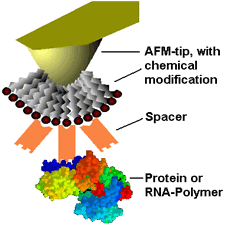Chemical Force Microscopy (CFM)
Chemical force microscopy (CFM) was developed by NanoCraft Coating GmbH. The CFM makes it possible to characterize your surfaces and samples chemically. Data on individual elements, molecules, macroscopic material properties and single chemical functional groups are collected on surfaces. The analyzed nanoscale and microscale surface areas can be summarized in graphical representations.
Operating Principle of Chemical Force Microscopy

A specially prepared AFM measuring tip is densely coated with a specific chemical end group (for example -OH, -CH3, -CF3, -NH2 or -COOH) using a technique developed by NanoCraft Coating GmbH. This provides a chemically uniform surface on the AFM probe. Specific interactions between the CFM measuring probe and the surface to be scanned can be imaged by selecting a specific medium (such as water, pH-stabilized solutions or solvents). The strength of the measured interaction between surface and CFM tip allows conclusions to be drawn about the density of the chemical end groups on the surface.
The CFM probe comes into contact with the surface at each measuring point and is then disconnected (Digital Pulsed Force Mode). The entire surface is scanned line by line. This physical process simultaneously determines the topography, the strength/energy of the interaction and the rigidity of the surface. In the following, these can be graphically assigned to a pixel.
CFM offers a wide range of potential applications:
- Imaging of surfaces with chemical contrast
- Image of hydrophilic/hydrophobic contrasts
- Specific imaging of biological surfaces
- Specific detection of OH groups
- Direct determination of intermolecular forces
- Determination of adhesive forces
- Determination of interparticular interactions
- Induction of locally defined chemical reactions
We are also happy to offer you our expertise as a service provider.
